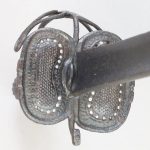
English Civil War / Restoration Period Officers’ Walloon Sword
To enquire about this itemplease click here
Price: £975
Ref: 42020368
Item Description
English Walloon Swords were mainly produced from the second to the fourth quarters of the 17th century. The pierced guard plates which are typical of the hilt design were influenced by earlier developments in Europe, which were combined with the features of existing English sword styles, to create this unique form of English hilt.
English Walloons provided a stylish alternative to the other sword patterns that were in use throughout the English Civil War period, the Restoration period, and in the battles fought during the Glorious Revolution of 1688 when James II was deposed. Most usually these are cavalry swords mounted with single edged blades. Some English rapiers were also clearly influenced by the Walloon style.
This sword is mounted with a backsword blade and its delicate construction indicates that it was made for a military officer. The hilt is made up of slender rounded bars built upon a sturdy quillon block. The cross bar is extended into a rear quillon which terminates in a drooping wristguard with a flat square finial. To the front, the quillon is extended into a knuckle bow, the flat grooved terminal of which is tucked into an aperture located at the front lower part of the pommel. Robust oval ring guards are mounted on each side of the cross bar, each with decorative bisected pairs of square shapes in the outer middle. Each ring is filled with a slightly downwardly convex plate, intricately engraved and pierced with concentric oval designs.
The plates are integral in the manufacture of the ring guards rather than of separate manufacture sprung into place in grooves chiselled around the insides of the rings. The sprung plates are a later European development rarely present on English swords of this time.
The knucklebow has two subsidiary scrolled bars emanating each side from just below halfway which splay and conjoin with the edges of the ring guards to strengthen the hilt structure. The hilt floor has a raised platform on the inside which supports the grip, and integral rounded langets emanate from the cross guard below on each side of the blade. The stylistic influence of contemporary English “Mortuary” hilts on these features is apparent. The cylindrical pommel has deeply fluted sides with an integral raised button on top and a flared neck beneath. The slightly baluster shaped wooden grip is bound with a strand of twisted brass wire.
The single edged blade has a deep shallow fuller running underneath the back edge on both sides for the length of the blade which is double edged near the tip.
The overall length of the sword is 38 inches (96.5 cm) and the blade is 32 inches (81.5 cm) long. Overall the sword is in russet, original and uncleaned condition.
For further information on English Walloon swords, and to see similar examples, see Stuart C Mowbray, “British Military Swords – Volume One: 1600 to 1660”, Mowbray Publishing, 2013, pages 246 to 254. See also for further discussion, Cyril Mazansky, British Basket Hilted Swords, Boydell Press 2005, Chapter 11, pages 281 to 284. The swords are described as “Hilts based on pierced side rings”.























